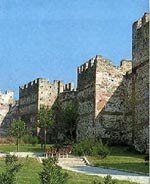Customer: Municipality of Thessaloniki
Duration: 1996
The study was assigned by the Municipality of Thessaloniki, in 1996. The study consisted of three phases:
– Analysis of the existing situation (Phase A’).
– Formulation of final proposals (Phase B’).
– Evaluation of these proposals (Phase C’).
The objective of the study was the development of proposals regarding the traffic and parking management in Ano Poli. There was a need to carry on a study because of the fact that the existing road network is not adequate and the existing traffic conditions are not satisfactory. In addition, there are many historic monuments in the area and so special care should be given for their conservation and accessibility.
The traffic data collection consisted of the following surveys:
• Identification of the existing land-use the urban characteristics of the area.
• Traffic volumes measurements in selected intersections of the road network.
• Identification of public transport system characteristics.
• Estimation of the parking demand and supply for on-street and off-street parking spaces.
• Survey of road accidents (last 3-year period).
• Survey of the characteristics of the existing road network (geometrical, pavement, etc).
• Identification of the pedestrianization schemes.
• Identification of the existing infrastructure which is offered for people with mobility problems.
The final proposals were formulated in phase B’ and concerned the following subjects:
• Estimation of the accessibility problems for the existing and future land use
• Promotion of historic buildings
• Improvement in the travel conditions of the pedestrians without worsening the travel and parking conditions for the car users.
• Short-term and long-term traffic management measures (pedestrianizations, changes in the geometrical characteristics of the intersections, changes in the signalling, etc).
Role of TREDIT:
– Collection and analysis of traffic data.
– Survey regarding the habitants and shop-owners opinions.
– Development of a traffic management model.
– Formulation of parking policies.
– Formulation of traffic management proposals

